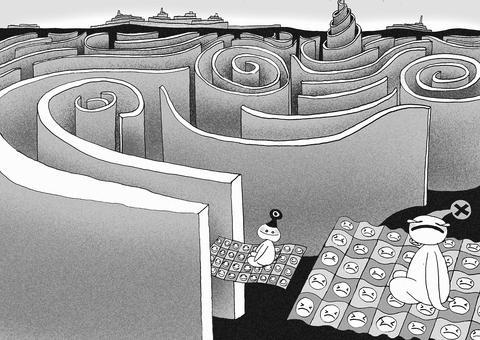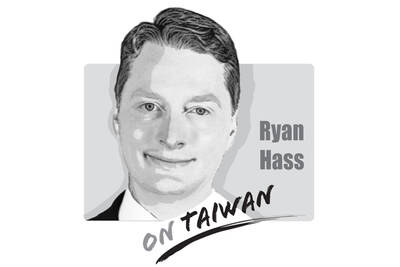Following the experiences of the EU's euro-zone region, a common currency area for Asia is being widely discussed. Even though an Asian monetary union is a fantasy that ignores both economic and political realities, even respectable economists have opined on the matter.
For example, Robert Mundell, a Nobel laureate in economics, has made statements in support of the creation of an Asian monetary union. Citing exchange rate volatility between the Japanese yen and the US dollar as being a problem for Asian economies, he suggested introducing a common currency area patterned on the euro-zone.
A private study group of the International Bureau of the Japanese Finance Ministry has promoted the idea of a unified currency for Asia.

ILLUSTRATION MOUNTAIN PEOPLE
Unsurprisingly, it begins with a plan for greater use of the yen in transactions in the region. The final report of the Study Group for the Promotion of the Internationalization of the Yen indicated that a unified currency would increase financial and economic cooperation among ASEAN countries, Japan, China and South Korea.
These proposals have not gone unheeded. ASEAN countries, along with Japan, China, and South Korea set up a system of swap agreements in May 2000 to reduce volatility in exchange rate fluctuations and to protect their currencies from speculative attacks.
In fact, there are many reasons that Asian countries should hesitate before making radical moves toward increased cooperation of their monetary authorities. In the first instance, coordinated monetary policy leads to a reduction in sovereignty. When an economy has free trade but fixed exchange rates, the domestic price level will fluctuate in order to absorb changes in international trade and financial flows. In the case of Hong Kong, it also brought a long cycle of deflation.
A more important point is that Asia does not constitute what economists refer to an "optimum currency area" whereby a single currency would generate net economic benefits. Supporters of an Asian currency union make a heroic assumption that East Asia might constitute such an area. However, this assertion reflects a political judgment that had little to do with the interconnectedness of Asian economies.
While there is more convergence in economic and political conditions in Europe, it is not clear that it is so well-suited to be a common currency area. One key element in the theoretic models is the high mobility of labor.
Language and cultural differences along with distrust of outsiders renders much of Europe's labor relatively immobile.
Needless to say, such differences in Asia are much wider than they are in Europe. Never mind migration barriers and diverse political regimes in Asia, there are widely uneven economic development patterns both within and between countries. While many rural areas depend upon agricultural output while urbanized regions depend upon manufacturing and energy production, the more advanced urban areas and city-states depend more heavily upon services. Consequently, external shocks will have asymmetrical impacts on different economic sectors of each country. And these shocks will impact upon the different geographical regions across countries and within each country. A single currency would eliminate the shock-absorbing capacity offered by national currencies. Without the safety-valve effect of a fluctuating local currency, unequal development between and within countries will become amplified and rigid.
An argument behind having a single currency is that it would reduce the costs of exchanging currencies by tourists, businesses and governments.
Added to the saving from avoiding these "transactions costs," there would be a reduction in the risk associated with holding foreign currencies. However, the reduction of money-changing costs does not require a unified currency. Technology has helped to reduce the costs to tourists of having national currencies that are supposed to be eliminated by currency union. Something as simple as credit cards has allowed people to minimize the costs of using multiple currencies.
Costs to tourists of transacting many different foreign currencies are trivial in value and volume to those that might confront companies with multinational dealings. And so it is that the development of new currency instruments allowed hedging strategies that are relatively low-cost for businesses. Innovations in the "financial derivatives" markets allow enterprises to avoid or minimize most of the risks of fluctuations in foreign currencies.
There is a case where a common currency can emerge spontaneously to benefit trading partners. As it is, the US dollar is already a commonly accepted currency used primarily for international trade. Local settlements could be carried out in the US currency that would circulate alongside national currencies. Following Gresham's Law, the less reliable currency would drive the good one out of circulation as a medium for transactions. The sounder money will become the basis of savings. If a local currency begins to weaken, savings can be converted into the dollar while the local currency would be used in daily transactions.
The good news is that implementing such a proposal does not require armies of researchers and international bureaucrats to hold conferences in five-star resorts. Of course, the bad news is that the people who benefit from such largesse would rather not give up the perks and importance.
Given the interventionist inclinations of politicians and international agencies, the construction of a single Asian currency is likely to be a complicated and evolutionary process. The first steps would involve closer coordination of monetary policies and some fixing of exchange rates.
Indeed, this is what happened in Europe with the so-called exchange-rate mechanism (ERM) that created massive short-run instability. In the early1990s, the Fed became concerned about holding down inflation and raised interest rates. As rates in the US rose, it caused pressures to de-link European currencies.
Eventually, the ERM broke down as massive currency realignments took place.
Attempts to rig foreign exchange markets have reinforced macroeconomic instability within much of Asia. Instead of spending time and money concocting pipe dreams that enrich researchers, it would be far better to initiate policies that promote investment by allowing private entrepreneurs to keep more of the fruits of their efforts.
Only politicians and social engineers believe that economic developments follow political constructions. In the real world, economic forces set limits and provide the momentum for the success of political arrangements.
When these forces clash, politics will ultimately be the loser.
Unfortunately, the adjustment periods involve real economic pain due to dislocations, misallocations and inefficiencies arising from political decisions that conflict with economic forces.
Christopher Lingle is professor of economics at Universidad Francisco Marroque in Guatemala.

China has not been a top-tier issue for much of the second Trump administration. Instead, Trump has focused considerable energy on Ukraine, Israel, Iran, and defending America’s borders. At home, Trump has been busy passing an overhaul to America’s tax system, deporting unlawful immigrants, and targeting his political enemies. More recently, he has been consumed by the fallout of a political scandal involving his past relationship with a disgraced sex offender. When the administration has focused on China, there has not been a consistent throughline in its approach or its public statements. This lack of overarching narrative likely reflects a combination
US President Donald Trump’s alleged request that Taiwanese President William Lai (賴清德) not stop in New York while traveling to three of Taiwan’s diplomatic allies, after his administration also rescheduled a visit to Washington by the minister of national defense, sets an unwise precedent and risks locking the US into a trajectory of either direct conflict with the People’s Republic of China (PRC) or capitulation to it over Taiwan. Taiwanese authorities have said that no plans to request a stopover in the US had been submitted to Washington, but Trump shared a direct call with Chinese President Xi Jinping (習近平)
Heavy rains over the past week have overwhelmed southern and central Taiwan, with flooding, landslides, road closures, damage to property and the evacuations of thousands of people. Schools and offices were closed in some areas due to the deluge throughout the week. The heavy downpours brought by the southwest monsoon are a second blow to a region still recovering from last month’s Typhoon Danas. Strong winds and significant rain from the storm inflicted more than NT$2.6 billion (US$86.6 million) in agricultural losses, and damaged more than 23,000 roofs and a record high of nearly 2,500 utility poles, causing power outages. As
The greatest pressure Taiwan has faced in negotiations stems from its continuously growing trade surplus with the US. Taiwan’s trade surplus with the US reached an unprecedented high last year, surging by 54.6 percent from the previous year and placing it among the top six countries with which the US has a trade deficit. The figures became Washington’s primary reason for adopting its firm stance and demanding substantial concessions from Taipei, which put Taiwan at somewhat of a disadvantage at the negotiating table. Taiwan’s most crucial bargaining chip is undoubtedly its key position in the global semiconductor supply chain, which led